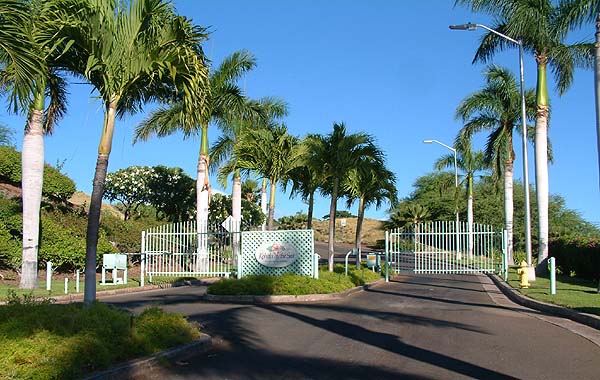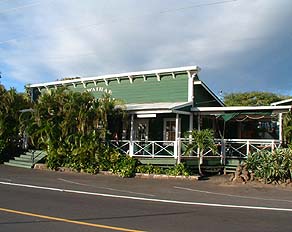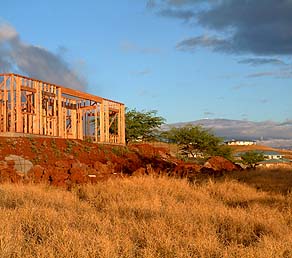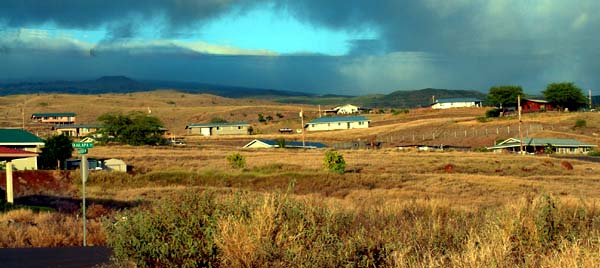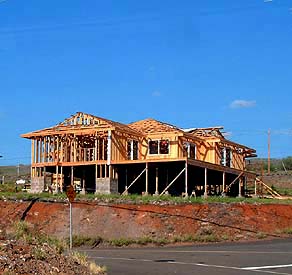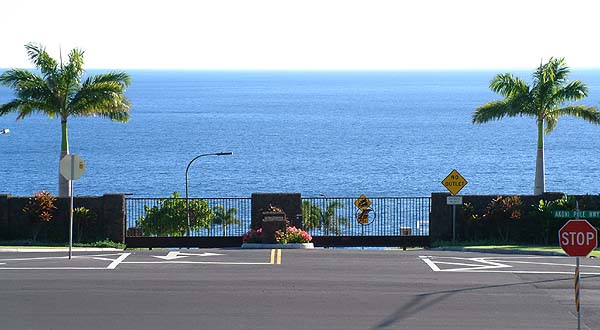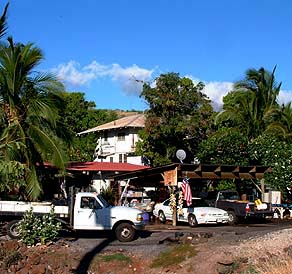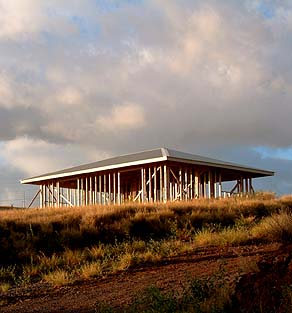 |
 |
 |
|||||
|
|
|||||||
|
|
|
|
“There’s not too many of the people that originally lived there living in Kawaihae any more,” ‘Ilima points out. “There are a few. But when Hawaiian Homes opened, we had a lot of people that came from all over the State, and moved there. Since it’s Hawaiian home land, we have Hawaiian community there. "But then you still have a lot of haole people because they live in Puako, and they come this side. And then, of course you have the military."
|
||
|
|
||
“We don’t have the aloha like we used to. I think everywhere, as new people move in and the surrounding area changes, everything is so fast, fast, fast. Not as fast as if you go to a city, but it seems like people have no time for each other. “How it used to be, if you went to Chock Hoo Store, you’d sit there and before you knew it a whole bunch of people were there and you would be talking story and sharing and eating. That was the beautiful thing about it. And also at Doi Store. “You don’t have that any more; people will just come and go and say ‘hi.’ But then, I like it because we can make new friends. I think that’s one of the positives. We can make new friends and meet new people."
|
|
|
“There’s Hawaiian Homelands further up the road,” Ku‘ulei notes, “mauka, and on the makai side now, they just opened that up within the last 15, 20 years. Some people lived there for quite a few years before anything happened. There were living on dirt roads up there because they were awarded those lots and they had no infrastructure. "So now they have the whole new subdivision and it’s big and new and now they’re starting to fill those lots. So that will replenish the Hawaiian population. Not so much in Kawaihae. But on the outskirts of Kawaihae." “There are a lot of houses coming up,” Lala points out. “Hawaiian Homes, Kohala Estates. A few of them are related to the old timers from down here. My daughter got one up there. She has just been there for a year, less than a year. They build self-built homes there. It’s cheaper. There’s about ten homes coming up, but the contractor’s going to build it.”
|
|
|
|
|
“Ever since we opened up the new subdivision further on up the hill, we have a lot of people come in from O‘ahu,” Pua remarks. “They come back from the Mainland. "We have this couple, they’re trying to build a house. And it’s been a while since they’re trying to build, but the carpenters who were building the home said that they can hear people talking in that house. And they’re thinking that maybe it’s his guys, but when he goes and checks, and finds out, ‘What were you saying?’ and they go, ‘Why, we’re not talking to anyone.’ But he said, ‘I heard people talking in this house.’ So they left. The homeowners know that there is some talking going on around here. And I don’t think they moved in yet.” “They have a trail in there, an old Hawaiian trail,” Louie adds. “Might have, I don’t know. But you have things like that, it’s bound to be. Guys working in the yard, daytime, they hear somebody talking, but there's nobody around.”
|
||
|
|
||
“I have relatives in Waimea,” Lala says. “But they all moved out; they moved to Honolulu. All sorts of people moved to Honolulu. The Carvalhos had a big reunion down at the Spencer Park. I’ve been there. The Akaus, the Akos. Not much left though. The Kapules, they’re not here.” “We had a big Kawaihae reunion a few years ago,” Lani concurs, “at Spencer Park. I planned it. All the family was there, it was really good. Even from Honolulu. And I had T-shirts made up. More than 100 people came. We had a big party. I had somebody make kalua pig and all that. But everybody had to bring something, pot luck, you know. I still keep in touch with all these people.”
|
|
|
“There is definitely a native population,” Ku says, regarding the Waimea-Kawaihae area. “We have the native population because there’s such a large Homestead in Kawaihae. And then up here in Waimea too, there’s that Homestead, because other than that, nobody can afford any kind of real estate in this area at all. “And there’s a relatively small ‘local’ population. I mean relatively small in relation to other places of this size. The local population in our area is much smaller than in other places that had more of a sugar cane economy. "Those who would be called ‘local’ means the people that came in from the plantations or have been here for quite a while, that second generation of people born and raised in Hawai‘i irregardless of ethnicity, but apart from the native community. And so that’s a relatively small community."
|
|
|
|
|
“Then we have a relatively large, brand new Caucasian population. And so there’s a bigger gap here than there is anywhere else. I think the dynamics here are different than in other places in Hawai‘i where that local group really is that stabilizing middle class. We don’t really have that so much. “It’s a rather above-average-affluence Caucasian population that’s very recent—between ten years maximum with the rest moving in from five years ago up until now. They are continuously moving here in very large numbers." “They got Kohala by the Sea,” Pua points out, “and they have this other gated area, it’s been there for a while. But these are the rich and famous people that live there. I never see these people, because they all come from the Mainland. “But you know, it doesn’t make sense to me, because here is a Hawaiian Homes, and here’s this gated area with all the beautiful homes. And these people, they don’t know when Kawaihae gets windy, and they don’t know when it’s rough. I mean, when over here gets rough, I get up at night because it’s pounding so bad that it shakes our house. I’m standing in the kitchen, and the moon is up, I don’t need to put the light on. I can see the wave rising and when it hits the shoreline and poof!”
|
||
|
|
||
“What really bothers me about the people that come here and buy property and want to own a piece of Hawai‘i,” Ku‘ulei remarks, “is that a lot of these people come from a background where they have no connection to their land. There’s nothing that ties them to the property. "This house is sixty years old. It’s termite-eaten, the roof leaks, the electrical is questionable. I continue to live in this house and refuse to give it up because I feel like I’ve done a lot with the property, my parents chiseled out a living here. There was nothing here, but they had nowhere else to go. This was home."
|
|
|
“Now, we as Hawaiian people, and the local people—all the Japanese people, all the Filipino people, all the Chinese people, Portuguese people, everybody that lives here—we know we live on an island. It’s a mind-set: you cannot make trouble with your neighbors and keep making trouble with your neighbors and stay alive on this island or be wanted here, because it’s a small community. Everybody knows that everybody else has a right too, and naturally there’s a lot of respect for everybody else. “But a lot of these people that come here have no respect. Their mighty God is the Almighty Dollar and ‘I have a lot of it and I can buy what I want.’ And, yes they can. They’ve been allowed to. The government has just let it all turn loose. They have just thrown all rights of people who came from this place to the wind because I don’t think they know how to manage it. And everybody’s out for themselves."
|
|
|
|
“This is a beautiful place,” Ku remarks, “and the idea in America is, if you have money you can be in any beautiful place that you want to be. And given the limited room we have on our island, sooner or later there’s not going to be any realty anymore. So how long are we going to wait before we actively talk about those kind of issues and deal with it? There’s a lot of work to be done. But we’re hoping that we can show that it can be a win-win situation.”
|
||
|
|
||
The disruption caused by developments in Kawaihae also strongly affect the health and sense of unity within the ahupua‘a as a whole.
|
||
|
|
||
|
|
|
|
|
|

|
| Kawaihae Home | Map Library | Site Map | Pacific Worlds Home |
|
|
|
|
|
|
|||
| Copyright 2006 Pacific Worlds & Associates • Usage Policy • Webmaster |
|||
